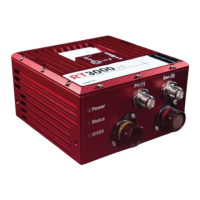Oxford Technical Solutions Ltd Page 61 of 110
The Host address needs to be entered to receive corrections. This is the domain name or IP address of the
caster or service that will be used. This should be provided by the service provider.
The Port is set to 2101 by default. The port should not be changed, or corrections will not be received by the
unit.
The Mounting point can be selected from the list available. This list will automatically populate, unless the
service provider requires authentication when collecting the information. If the NTRIP service is protected by a
login, the list of mounting points will have to be accessed manually and the mounting point typed into the field.
The User name and password for the correction stream need to be inputted for the RT to be able to receive the
data from the caster. Please note that this is not the same user name and password as the account held with
the service provider.
Networked DGPS (WLAN)
The Networked DGPS (WLAN) controls allow an RT to be configured to broadcast or receive differential
corrections over Wi-Fi when connected to an RT-XLAN. When Network correction transmitter is selected, an
RT will broadcast differential corrections it is receiving via a radio modem from an OxTS base station, using its
RT-XLAN. Other RT devices that are on the network as the broadcasting RT, will then be able to receive the
DGPS messages and use them. To do this, the Network correction receiver option should be selected on those
devices, and the IP address of the system carrying the radio modem should be selected from the box. Using
this system reduces complexity in situations where multiple RTs need DGPS corrections as only one pair of
radio modems needs to be used.
Networked DGPS (WLAN) can also use corrections received via NTRIP, rather than a local base station. As
before, the RT that is connected to the NTRIP server should be configured with Network correction transmitter
selected. Other RTs should be configured with Network correction receiver selected, and the IP address of the
system that is configured as the transmitter should be selected in the box.
Regardless of whether DGPS corrections are received via NTRIP or a local base station, only RTCMv3 corrections
are currently supported in networked DGPS mode.
SBAS
In Europe, North America, and Japan SBAS can be used for differential corrections. These services will improve
the position accuracy of the RT. In North America the SBAS service is known as WAAS, in Europe it is known as
EGNOS and in Japan it is known as MSAS. Select the option that is most suitable for the territory you are in.
TerraStar corrections
TerraStar corrections are configured on the GNSS Differential Corrections tab within the Hardware Setup
section. You can choose between Manual or Automatic Satellite Selection and if you choose Manual you can
select from a list of available options. Using the “Advanced Settings” checkbox you can also change the
frequency and baud rate.

